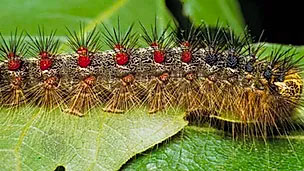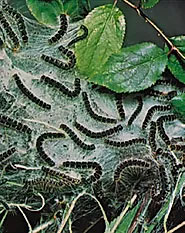
Aside from our regular program of services, Emerald Acres provides tall tree spraying to control gypsy moth caterpillars, tent caterpillars and fall webworms. Pressure from the gypsy moth caterpillar has abated over the past few years, though they are by no means gone. Several areas have recurring problems with these fuzzy pests, and every ten years or so the population increases dramatically across the board.
Many people mistake the gypsy moth caterpillar for the tent caterpillar. They have similar life cycles in that both hatch each April from eggs laid in the fall. However, they are very different in their behavior once they have hatched.

The tiny gypsy moth caterpillars hatch close to the ground in egg masses deposited on tree trunks and in stone walls, etc. These baby caterpillars spin a thin strand of silk into the air. Once caught by a breeze, the strand carries the caterpillar up into the branches of surrounding trees. The caterpillars quickly grow by feeding voraciously on deciduous plantings. If populations are high enough, they will move on to evergreens once more favorable foliage has been devoured. The insects tend to come down from the trees in the evening and return to feed each day. Hence, some control has been achieved by wrapping tree trunks with sticky strips. This control however, has proven to be quite limited.

The tent caterpillars hatch in the tree branches themselves. They immediately begin feeding on surrounding foliage while spinning an all-encompassing web. Tent caterpillars tend to reproduce in specific varieties of trees. They love choke cherries, crab apples, and others, and will return each year to these varieties. Again, once the tree is defoliated they will move on to surrounding plantings. In the case of choke cherries, we often recommend removal. The choke cherry is not an attractive tree in the first place. By cutting out one or two scrappy trees you may prevent annual infestation of these and surrounding shrubbery.
Gypsy moth caterpillars and tent caterpillars can be treated simultaneously with usually only one insecticide application. This will not, however, control the fall webworm, which produces damage similar to the tent caterpillar except for its fall timing and prevalence in taller trees. Treatment is made by our tall tree sprayers that can reach near 100ft. Charges depend on the number and size of the trees being treated. As always, estimates are free!
Written By: Terence Boots
Massachusetts Certified Arborist
Owner: Emerald Acres Inc.
